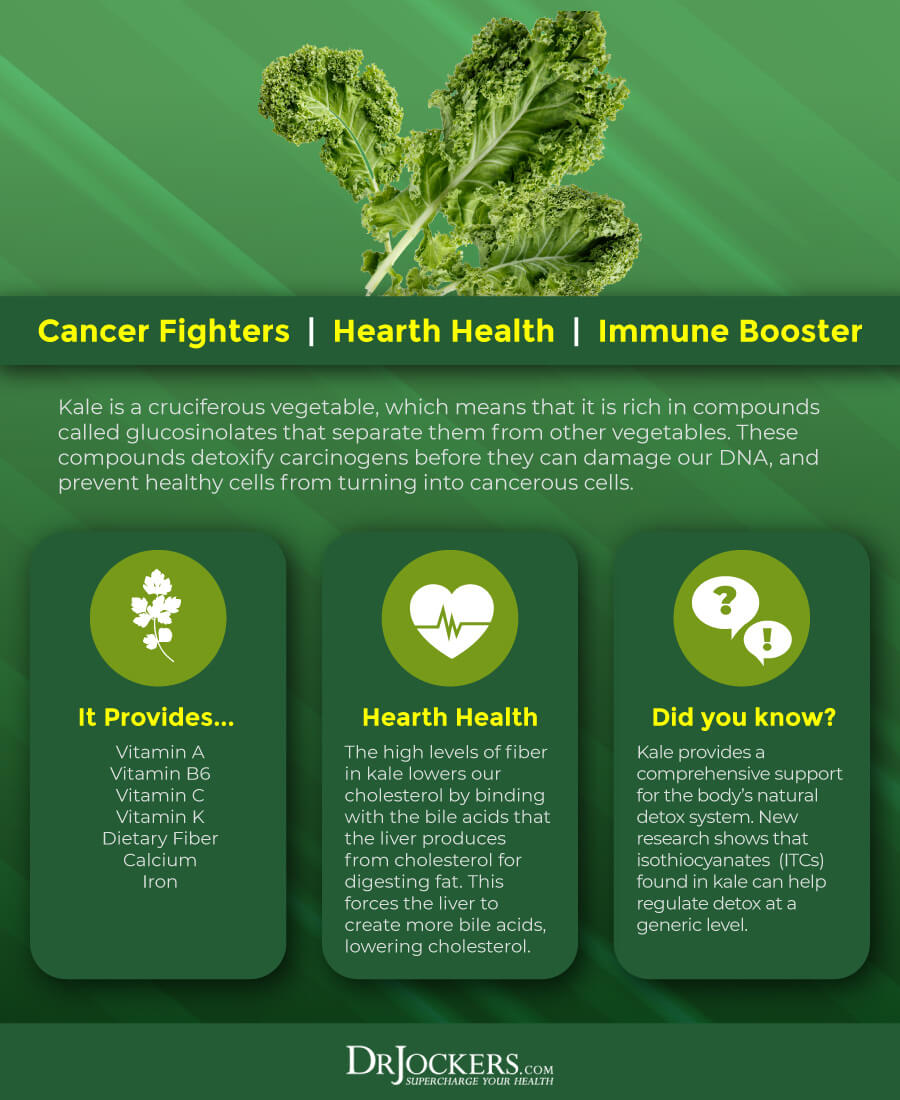6 Incredible Health Benefits of Kale
Foods that have an incredible array of health benefits that go well beyond just their nutrient value are considered `super-foods.` Kale is widely regarded as one of the world’s most powerful superfoods. It is a member of the Brassica family of vegetables that includes cabbage, collards, and brussels sprouts. These vegetables are known for their richness in anti-oxidants and sulfur containing phytonutrients.
Some of the hottest nutrients present in kale include the glucosinolates and methyl cysteine sulfoxides. These super-nutrients help to activate detoxifying enzymes in the liver that play an important role in neutralizing carcinogenic substances.
One such glucosinolate, sulfuraphane, is formed when kale is either chopped or chewed. Sulfuraphane has been shown to alter the genetic expression of the liver allowing to more effectively use its detoxification enzymes (1, 2, 3).

Kale is Rich in Cancer Fighting Nutrients:
Another glucosinolate phytonutrient present in kale are isothiocyanates. Isothiocyanates have been shown to inhibit carcinogenesis and causes cancer cell apoptosis (4, 5). When kale is broken (chopped or chewed) an enzyme myrosinase interacts with glucosinolates to release isothiocynates.
This increases the amount absorbed by the body. However, the absorption of isothiocyanates is lower from cooked than from raw kale. In fact, boiling kale from 9-15 minutes can result in an 18-59% decrease in the total glucosinolate content (6). Steaming or sautéing kale reduces nutrient losses.
Kale is an especially potent source of antioxidant phytonutrients. In fact, kale ranks highest among all vegetables in its concentration of the carotenoids beta-carotene, lutein and zeaxanthin. These yellow-orange pigments are critical for the plants defense against excess solar radiation.
They have become such a natural health phenomena that the USDA has invested over $800,000 into a four-year “Carotenoid Project.” This project has brought together Dr. Dean Kopsell (plant biologist) and Dr. Joanne Curran-Celentano (nutritional scientist). Kopsell and Curran-Celentano are studying the details of carotenoids and their role in human health.

Kale Protects us from UV Light Radiation
According to Kopsell, plants evolved carotenoids in order to protect themselves from high levels of UV light exposure. “Plants use only about one or two percent of the light energy falling on the leaf surface for photosynthesis,” Kopsell says. “In plants, lutein and zeaxanthin play a role in absorbing light outside the red and blue range and funneling it away, in essence acting as a chemical “sun block” that helps protect the pant from excessive radiation.” (7) Many have theorized that carotenoids play a similar role when they concentrate in the macula lutea, the region of highest visual acuity in the human eye.
The Curran-Celentano’s project analyzed twenty-three varieties of kale and all the genetic, environmental, & geographical factors to maximize the amount of xanthopyll carotenoids lutein and zeaxanthin. They also modified the sulfur and nitrogen content of soils to alter antioxidant content and temper the strong flavors in kale that some people don’t like. The researchers discovered the varieties with the highest concentrations had two and a half times the carotenoid levels of those with the lowest concentrations (8).
These findings indicate that the nutritional value of the kale comes down to the conditions of the soil it was grown in. Soil health is strongly dependent upon the composting, fertilizing, and rotational cycles used by the farmer. It has been shown that organic varieties of kale grown in nutrient rich soil are superior to commercially grown varieties of kale. It is highly recommended to seek out kale from local, organically grown farms and gardens.

Sources For This Article Include:
1. Zhao HD, Zhang F, Shen G, Li YB, Li YH, Jing HR, Ma LF, Yao JH, Tian XF. Sulforaphane protects liver injury induced by intestinal ischemia reperfusion through Nrf2-ARE pathway. World J Gastroenterol. 2010 Jun 28;16(24):3002-10. PMID:20572303
2. Myzak MC, Dashwood RH. Chemoprotection by sulforaphane: keep one eye beyond Keap1. Cancer Lett. 2006 Feb 28;233(2):208-18. Review. PMID: 16520150
3. Guerrero-Beltrán CE, Calderón-Oliver M, Pedraza-Chaverri J, Chirino YI. Protective effect of sulforaphane against oxidative stress: recent advances. Exp Toxicol Pathol. 2012 Jul;64(5):503-8. PMID: 21129940
4. Yang Y, Yan H, Li Y, Yang ST, Zhang X. Isothiocyanates from Broccolini seeds induce apoptosis in human colon cancer cells: proteomic and bioinformatic analyses. Pharmazie. 2011 May;66(5):382-90. PMID: 21699074
5. Abbaoui B, Riedl KM, Ralston RA, Thomas-Ahner JM, Schwartz SJ, Clinton SK, Mortazavi A. Inhibition of bladder cancer by broccoli isothiocyanates sulforaphane and erucin: characterization, metabolism, and interconversion. Mol Nutr Food Res. 2012 Nov;56(11):1675-87 PMID: 23038615
6. McNaughton SA, Marks GC. Development of a food composition database for the estimation of dietary intakes of glucosinolates, the biologically active constituents of cruciferous vegetables. Br J Nutr. 2003;90(3):687-697. PMID: 13129476
7. Kopsell, et al. The Effects of Ultraviolet Radiation on Pigment Production, Growth, and Photochemical Efficiency in Allium spp. Masters Thesis at University of Tennessee. April 2009: Link
8. Kopsell, et al. Genetic and environmental influences on the nutritional content of vegetable brassicas. United States Department of Agriculture. Oct 2001- Sept 30th Link



